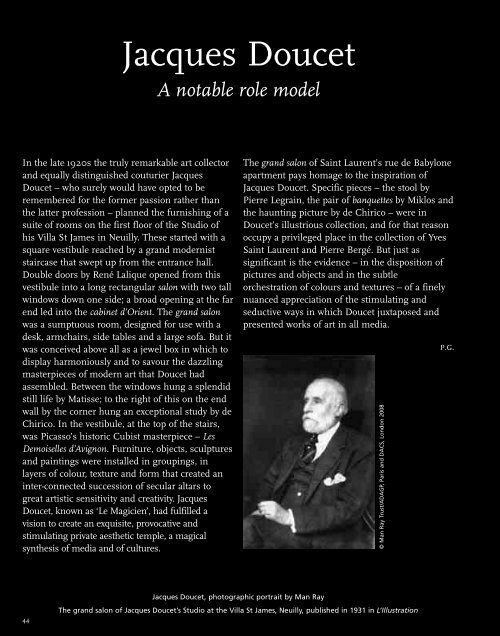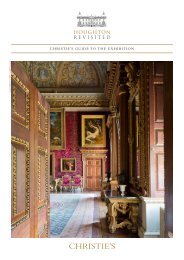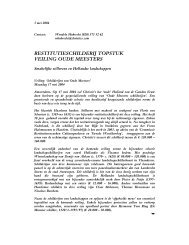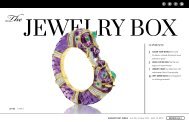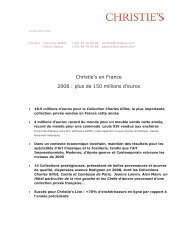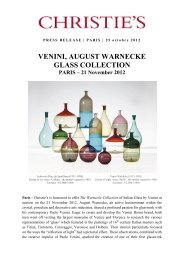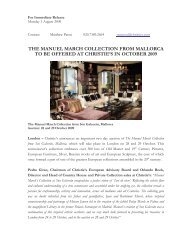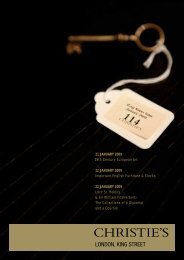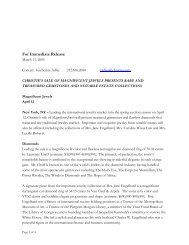Yves Saint Laurent Pierre Bergé - Christie's
Yves Saint Laurent Pierre Bergé - Christie's
Yves Saint Laurent Pierre Bergé - Christie's
You also want an ePaper? Increase the reach of your titles
YUMPU automatically turns print PDFs into web optimized ePapers that Google loves.
44<br />
Jacques Doucet<br />
In the late 1920s the truly remarkable art collector<br />
and equally distinguished couturier Jacques<br />
Doucet – who surely would have opted to be<br />
remembered for the former passion rather than<br />
the latter profession – planned the furnishing of a<br />
suite of rooms on the first floor of the Studio of<br />
his Villa St James in Neuilly. These started with a<br />
square vestibule reached by a grand modernist<br />
staircase that swept up from the entrance hall.<br />
Double doors by René Lalique opened from this<br />
vestibule into a long rectangular salon with two tall<br />
windows down one side; a broad opening at the far<br />
end led into the cabinet d’Orient. The grand salon<br />
was a sumptuous room, designed for use with a<br />
desk, armchairs, side tables and a large sofa. But it<br />
was conceived above all as a jewel box in which to<br />
display harmoniously and to savour the dazzling<br />
masterpieces of modern art that Doucet had<br />
assembled. Between the windows hung a splendid<br />
still life by Matisse; to the right of this on the end<br />
wall by the corner hung an exceptional study by de<br />
Chirico. In the vestibule, at the top of the stairs,<br />
was Picasso’s historic Cubist masterpiece – Les<br />
Demoiselles d’Avignon. Furniture, objects, sculptures<br />
and paintings were installed in groupings, in<br />
layers of colour, texture and form that created an<br />
inter-connected succession of secular altars to<br />
great artistic sensitivity and creativity. Jacques<br />
Doucet, known as ‘Le Magicien’, had fulfilled a<br />
vision to create an exquisite, provocative and<br />
stimulating private aesthetic temple, a magical<br />
synthesis of media and of cultures.<br />
A notable role model<br />
The grand salon of <strong>Saint</strong> <strong>Laurent</strong>’s rue de Babylone<br />
apartment pays homage to the inspiration of<br />
Jacques Doucet. Specific pieces – the stool by<br />
<strong>Pierre</strong> Legrain, the pair of banquettes by Miklos and<br />
the haunting picture by de Chirico – were in<br />
Doucet’s illustrious collection, and for that reason<br />
occupy a privileged place in the collection of <strong>Yves</strong><br />
<strong>Saint</strong> <strong>Laurent</strong> and <strong>Pierre</strong> <strong>Bergé</strong>. But just as<br />
significant is the evidence – in the disposition of<br />
pictures and objects and in the subtle<br />
orchestration of colours and textures – of a finely<br />
nuanced appreciation of the stimulating and<br />
seductive ways in which Doucet juxtaposed and<br />
presented works of art in all media.<br />
Jacques Doucet, photographic portrait by Man Ray<br />
The grand salon of Jacques Doucet’s Studio at the Villa St James, Neuilly, published in 1931 in L’Illustration<br />
© Man Ray Trust/ADAGP, Paris and DACS, London 2008<br />
P.G.


